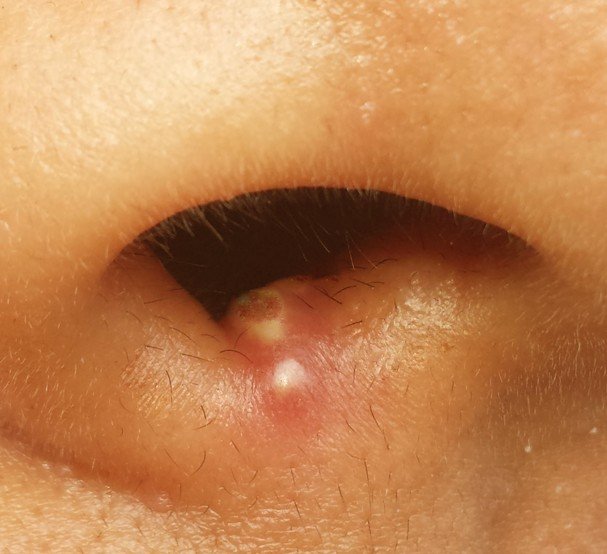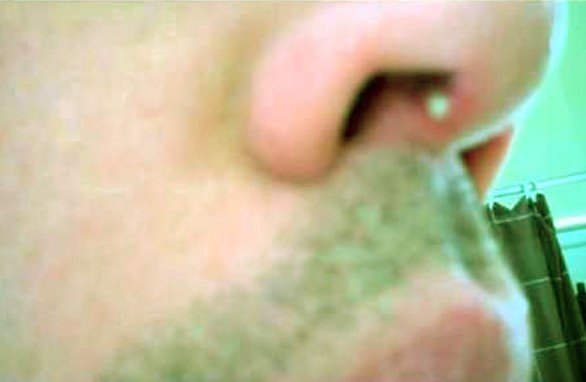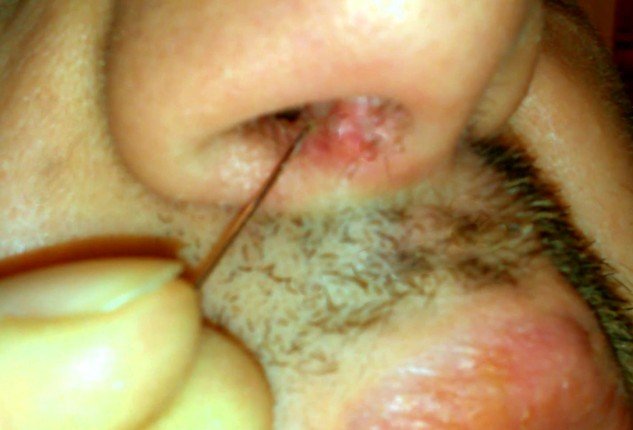What does Pimple in Nose mean?
Having a pimple inside the nose is not a pleasant thing to deal with, as it can cause a lot of discomfort and even main. In some situations, the pimple is a sign of underlying infection. It is important to obtain a correct diagnosis and learn how to take care of the infected pimple, without further aggravating or spreading the infection.

Picture showing Pimple in nose
Presentation
The pimple can appear in different areas of the nasal mucosa, including at: nasal wings, nasal passage vestibule, nasal septum and nasal floor. Before the pimple actually starts forming, the respective area becomes red and there is tenderness to the touch. As the bacteria colonize the area, the white cells come to battle, causing inflammation. Apart from the actual pimple (whitehead), you can present fever, headaches and a general state of not feeling well (systemic bacterial infection).
Depending on how big the pimple becomes, it may press on the nasal tissues, leading to discomfort or pain. The pimple will most commonly open on its own, with pus and blood appearing as discharge. As the pimple bursts, one feels a reduction in the amount of pressure, with symptoms such as pain and inflammation being improved. In the situation that a furuncle is present at the level of the nasal mucosa, the patient might be in serious pain and the breathing might be impaired (requiring surgical intervention for the drainage of the furuncle).
What Causes Pimple in Nose?
These are the most common causes that can lead to the appearance of a pimple inside the nose:
Blocked pores
- Cause – excess oil production (sebum), accumulation of dead skin cells
Bacterial infection
- The bacteria can infiltrate into the nasal pores, leading to redness and irritation in the first phase
- The inflammation around the pimple makes the area tender, if not painful to the touch
- In case of severe infection, the pimple can transform into a furuncle
- The bacteria can colonize the inside of the nose through:
- Dirty hands
- Contaminated water
- Expired/low quality skin care/hygiene products.
Folliculitis (nasal vestibulitis)
- Staphylococcal infection
- Collection of white or red pimples (at the hair follicle)
- May be brought upon or aggravated by certain habits, such as nose picking or excessive nose blowing
Infection with methicillin-resistant staphylococcus aureus (MRSA)
- May lead to an aggravation of the pimple – cellulitis
- The infection can propagate to other parts of the body
- Difficult to treat, due to the high resistance to antibiotics
Other causes
- Chronic sinusitis
- Swollen adenoids (nasal polyps)
- Reduced immunity (other chronic illnesses)
- Parasitic infection (worms – more commonly in children)
- Pulling out the nose hairs (increased chance for bacterial infection)
- Allergic rhinitis (inhalation of allergens – clogged mucosa)
Diagnosis of Pimple in nose
These are the most common methods used for the diagnosis of the pimple inside the nose:
- Patient’s medical history
- When did the pimple appear
- Are there other symptoms present
- Was there any discharge from the pimple (blood, pus)
- Physical examination
- Analysis of nasal mucosa
- Imaging studies (CT, MRI)
- Recommended in the situation that a sinus infection or other complications are suspected
- Blood testing
- Identification of bacteria responsible for the systemic infection
- May be accompanied by a sample of the liquid that is drained from the pimple.
How to Get Rid of a Pimple in Your Nose
In order to treat the pimple inside the nose, one must first identify the correct cause that has led to such problems in the first place. Personal hygiene has to be improved, in order to reduce the bacterial overgrowth and eliminate the risks for secondary infections. Antibiotics represent the standard treatment approach, with topical ointments being most commonly recommended (bacitracin, mupirocin). In the situation that the patient suffers from a systemic infection, it is possible that oral antibiotics are prescribed. Severe bacterial infections require admission into the hospital and the administration of intravenous antibiotics. If the pimple has transformed into a furuncle, surgical intervention is going to be necessary. The surgeon will intervene, performing the surgical drainage (pain and inflammation relief).
In order to deal with the symptoms of the pimple inside the nose, such as the pain and the inflammation, it is recommended that one takes non-steroidal anti-inflammatory medication. Among the most indicated choices, there are acetaminophen and ibuprofen. Warm compresses can be applied to the affected area, in order to promote the blood circulation into the area and a faster healing process. The warm compresses should be kept in place for about 15 to 20 minutes. It is also recommended that one avoids picking or scratching the pimple; attempting to pop the pimple before it is ripe is also a bad idea, as it can lead to secondary bacterial infections.
Steam inhalation might hydrate the mucosa and allow for the pimple to open, thus helping you drain the purulent discharge. Onion juice can also be applied at the level of the pimple, so as to guarantee a faster healing process. You can maintain the nasal mucosa clean, by wiping it with a cotton swab (previously dipped in hot water). Lemon juice and garlic applications can also help the pimple on the nose to heal. The same goes for neem, turmeric or cinnamon.
Complications
One of the complications that can occur in case of a severe infection is represented by the cavernous sinus thrombosis. This is because the infected pimples inside the nose are quite close to the brain. What happens is that a blood clot forms at the level of the pimple or furuncle, traveling to one of the most important parts of the brain, meaning the cavernous sinus. If such a complication occurs, the patient will experience severe headaches, pain and drowsiness. The vision might become impaired, with the eye bulging and double vision. Pain is felt at the level of the eyes, the pupils become uneven and the patient presents high-running fever.
Prevention
The pimple inside the nose can be prevented by maintaining an excellent hygiene. Apart from that, there are certain habits that you will have to give up. More specifically, you need to avoid picking your nose or blowing your nose excessively.
Pictures of Pimple in Nose

White Pimple inside nose

Pimple in nose with swollen lip

Pimple inside nose with swelling




